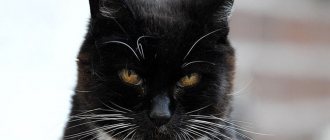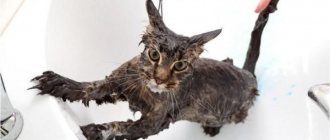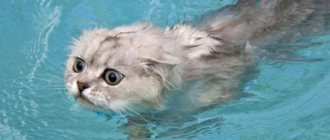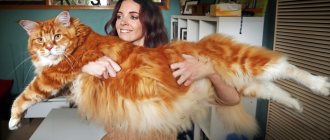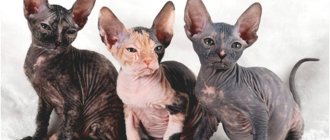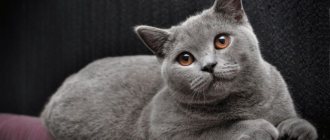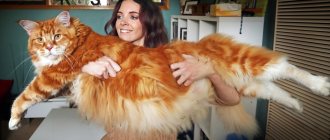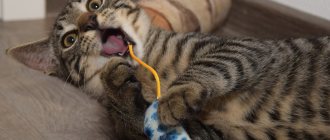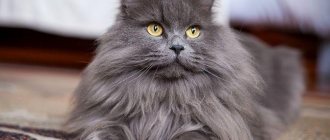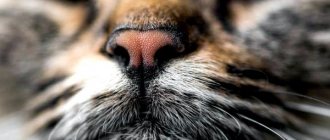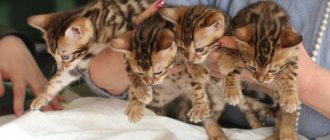Many are fascinated by the habits and appearance of wild cats (leopards, panthers, lynxes). These animals fascinate with their gracefulness, and there is a great desire to admire these cats every day! Thanks to breeders, it has become possible to have a pet with the appearance of a leopard or lynx. In this article, we have collected the top 10 cat breeds that look like a wild lynx.
Caracal
The caracal is a steppe lynx, whose habitat is Africa, the Arabian Peninsula, Asia Minor and Central Asia. Found in Turkmenistan. Caracals have lived alongside people for hundreds of years and are well tamed. Previously, they were even used instead of hunting dogs, and now exotic lovers keep them as pets.
Peculiarities:
- Height up to 85 cm, weight up to 22 kg;
- The caracal needs open areas and long walks outside (on a leash);
- They require special training, education and socialization from a very early age;
- They feed on whole carcasses of animals and birds (rats, mice, chickens);
- It is not recommended for families with children or other animals to own caracals;
- Price from 450,000 rub.
Caracal
Tendency to diseases
Being a descendant of the caracal, these hybrid cats have excellent health and are resistant to various types of infectious diseases. Excellent immunity inherited from a wild ancestor helps with this. A healthy animal has a powerful and well-functioning digestive system. It is necessary to receive all necessary vaccinations against rabies and feline viruses in a timely manner.
Deworming is carried out at least once every 3-4 months. You can pick up the drug at any veterinary pharmacy; the dosage is calculated based on the weight of the pet. If the animal is outdoors, it will require treatment for fleas and ticks. On sale you can find special drops for the withers, sprays, collars, etc.
Caraquet
Caracal (caracal + cat) is a hybrid of a male caracal and a domestic cat. Kittens inherit their appearance from their father, and their calm character from their mother. The breed was bred by chance 30 years ago, and in 2018, the first caraquet nursery was opened in Russia, in Krasnodar.
Peculiarities:
- Height up to 45 cm, weight up to 16 kg;
- Caracats cannot meow, they rather yap or chirp;
- The caraquet has dog-like habits: they fetch things, become attached to the owner, walk on a leash;
- They must be fed with small poultry and meat;
- Caracat can be type F1 (direct descendant of caracal), F2 ("grandson" of caracal, 25% wild genes), F3 (third generation from wild caracal, the most domestic and do not have the bright appearance of a wild cat);
- Price from 100,000 rub.
Photo of a caracat - a cat very similar to a lynx.
Choosing a kitten
When choosing a small pet of any of the hybrid breeds, you must first verify the authenticity of its origin. You should only purchase a kitten from a trusted breeder who is ready to provide all the necessary documents.
These animals are extremely expensive, their cost can exceed one million rubles, so the risk of deception is very high.
If you do not plan to breed caraquets in the future, then it is necessary to prepare for sterilization or castration in advance, otherwise the animals will inevitably mark their territory when they grow up. It is best to buy a pet after the operation has been performed.
You need to purchase a caraqueta only from a trusted and reliable breeder.
General selection criteria:
- the baby should look healthy, there should be no fluid or unpleasant odor coming from the ears and eyes;
- the skin should be clean, without rashes and various peelings;
- the fur should be shiny and thick (not sticky, rolled, etc.);
- The optimal age of a kitten is 3–4 months;
- all necessary vaccinations must be completed;
- the kitten should not be too aggressive, but not too timid (caracats are very balanced).
Maine Coon
The largest breed among domestic cats. It was developed in the USA, in Maine, but has spread throughout the world. Maine Coons are gentle giants. These cats are loved for their gentle disposition and unusual appearance, similar to a lynx: tufts on the ears, large paws, and a three-layer fur coat. In their “forest” color, Maine Coons especially resemble lynxes.
Peculiarities:
- Height up to 45 cm (body length up to 1 m), weight up to 12 kg;
- Very affectionate, perfect for families with children;
- Price from 15,000 rub.
Maine Coon
External features of the lynx
Lynx is a very beautiful animal, with its own distinctive features. She has so-called sideburns on the sides of her head, and tassels on her ears. The lynx's jaws are narrow and powerful, and its nose is wide and large.
The color of the coat depends on the habitat: from fawn-smoky to rusty-red, with small specks in the belly area. The fur is thick, soft, of varying lengths on different parts of the body. The spots on the lynx's body can be pronounced or barely noticeable, concentrated mainly in the back, sides and head. The tassels are always dark in color and can reach 4 cm in length.
In addition to external features, the lynx has excellent hearing, which is partly due to its brushes. For example, in nature she will be able to hear a hare crunching branches 100 meters away from her. Vision is also excellent, the lynx distinguishes colors well. The sense of smell is not very developed; it tracks prey well by following a fresh scent.
Kurilian Bobtail
These cats appeared on the Kuril Islands, their main external feature is a short tail. Kittens are already born with it, it's a genetic trait. It is this short tail, fluffy collar and green eyes that give the Kuril Bobtail its resemblance to a lynx.
Peculiarities:
- Height up to 35 cm, weight up to 7.5 kg;
- They resemble dogs in behavior (loyal, affectionate, obey their owner);
- Excellent hunters;
- They love company and are perfect for families with children;
- Price from 10,000 rub.
Kurilian Bobtail
American Bobtail
This is a relatively new breed that appeared in the States in the 60s of the 20th century. From childhood, kittens look like little lynxes: they are born with short tails and fluffy wings on their cheeks. The spotted or striped color gives it an additional resemblance to a lynx. The American Bobtail has hind legs that are slightly longer than the front legs, like a lynx. Therefore, even the gait resembles a trot. Despite all this, the American Bobtail is a very gentle and domestic creature.
Peculiarities:
- Height up to 30 cm, weight up to 6 kg;
- Quickly find a common language with people, cats, dogs;
- They become attached to a person;
- They tolerate moving well and adapt quickly;
- Price from 10,000 rub.
American Bobtail
Hurry up, choose a box and find out what gift awaits you
Discount on pet insurance
Promo code copied to clipboard
Pixiebob
Breeders bred this breed artificially because they wanted to get a domestic cat that looked like a lynx. For this purpose, forest cats were crossed with domestic cats. The result was a pixie-bob breed: strong bones, black rims around the eyes, a short tail and gray coloring with blurry spots. Lynx in miniature! But by nature, pixie bobs are very gentle.
Peculiarities:
- Height up to 35 cm, weight up to 8 kg;
- Very active, love to play for a long time and walk on a leash;
- Almost 50% of pixiebobs have extra toes. This is a genetic trait;
- They love water;
- Price from 15,000 rub.
Pixiebob
Chauzie
Chausie (Chausie, Hausie), unlike the two previous breeds, is short-haired. It was bred artificially by crossing a domestic cat with a wild jungle cat. The selection was purposeful - it was necessary to breed an absolutely domestic cat that would look like a wild one. This was done so that people would stop keeping wild animals in their homes. After all, such a neighborhood only brings harm to both one side and the other.
This program took place in the United States in the sixties and seventies of the last century. Many breeds of short-haired cats took part in it, and in the end the final choice fell on the Abyssinian. Now this breed is bred with its help.
The purity of the Chausie breed is checked according to the following standards:
| Sign | Description |
| Weight | 13–18 kg |
| Body type | Strong, muscular. But elegant. The chest is wide, square in shape |
| Limbs | Slightly longer than average, the front legs are shorter than the hind legs. Limb pads are small, rounded |
| Tail | Short, rather thin, slightly rounded at the end |
| Neck | Medium length, not too thick. Powerful and muscular |
| Head | Narrow, wedge-shaped. High cheekbones. The forehead is dome-shaped, this is more pronounced in males than in females. The muzzle is almost square in shape |
| Nose | Straight, sharply defined. Width - average, increases closer to the bridge of the nose |
| Eyes | Almond-shaped, medium-sized, slanting. Planted deep. Color yellow or golden |
| Ears | Large, set straight and wide |
| Wool | Short, close to the body |
| Color | Various tabi color options. Including the classic colors of the jungle cat, not found in other domestic cats. |
Character
Sociable and friendly. Shausies need the company of people, are affectionate, and require a lot of attention. Loyal to their master. But at the same time they do not like to sit on their hands. And you should pet them only when the pet wants it.
These cats are quite independent and rebellious. It will not be possible to completely tame her, and it is not worth it. It is quite possible to teach such an animal to go to the litter box and not sharpen its claws on the sofa. Chausies are smart, curious and inquisitive, and very active. They jump great. They have a highly developed hunting instinct. They are not afraid of water, and many individuals even love it.
Features of care
It is best to keep such a cat in a private home with the possibility of walking in a closed backyard. This condition must be observed so that the animal has the necessary space for play and does not turn the home into ruins.
It is recommended to pick up kittens of this breed as often as possible so that they get used to people. And an adult animal should pay as much attention as possible. Otherwise, the chausie may awaken the character of its wild ancestors.
Otherwise, these animals are unpretentious. They live long and have excellent health. They do not require any specialized care.
Norwegian forest
If you compare a wild lynx in a winter coat and a domestic Norwegian forest cat, you will see how similar they are. Especially if the Norwegian Forest is gray or tortoiseshell in color. All cats of this breed have charming fluffy ears with tufts. The Norwegian forests are famous for their tranquility. They are great companions, smart and slightly introverted.
Peculiarities:
- Height up to 40 cm, weight up to 10 kg;
- Long soft coat that needs careful grooming;
- Price from 5,000 rub.
Norwegian forest
Chausie
The Chausie is a cross between a domestic cat and a jungle cat. Breeders divide kittens into generations F1 (direct kitten from the jungle cat), F2 (grandson of the jungle cat) and F3 (great-grandson). Chausies are very large, energetic and sociable. They have a very domestic disposition, but they love it when life is in full swing around them, they have a lot of energy. Chausies will not tolerate being alone for 12-16 hours.
Height up to 40 cm, weight up to 16 kg;
Not suitable for families with small children;
Chausies are allergic to gluten and require a meat-based diet without grains or vegetables;
Recently, cats with tufted ears have become especially popular among pet lovers. This feature looks exotic, as if a real lynx lives in a house with a person. For such an animal with an unusual appearance, many connoisseurs are willing to pay a considerable price, and sometimes a whole “fortune”.
Caracal with tassels on ears. This is not a breed, but a wild animal!
Siberian cat
One of the largest breeds among domestic cats. They resemble a lynx in their gait, dark-rimmed eyes, and large soft paws. Otherwise, they are friendly pets. Despite their size, Siberians are very agile and elegant.
Peculiarities:
- Height up to 35 cm, weight up to 12 kg;
- This breed is suitable for allergy sufferers and is considered hypoallergenic;
- Three-layer fluffy fur requires careful care;
- Price from 5,000 rub.
Siberian cat
Castration and sterilization
Some breeders practice early spaying or neutering surgery. But veterinarians strongly advise not to do this until the pet is 11 months old, otherwise the animal’s body may remain underdeveloped. If you do not plan to engage in breeding work, then this procedure is mandatory.
Caraquet care after surgery
To avoid various complications, it is necessary to carefully monitor the animal’s condition after surgery. Proper and competent care consists of the following actions:
- put on a post-operative blanket and use a collar to prevent the cat from licking the stitches;
After the operation, the cat must be wearing a post-operative blanket.
- do not feed for 12 hours after surgery;
- regularly inspect the seam and treat it with chlorhexidine or other similar drugs;
- monitor your pet so that he does not try too actively to remove items of equipment that interfere with him;
- provide your pet with peace and quiet;
- if necessary, give painkillers (Ketofen, Pervicox, etc.), the dosage is prescribed by a veterinarian.
It is forbidden to give animals regular painkillers, in particular Paracetamol. This can lead to serious and irreversible consequences.
In alarming situations (the stitch looks bad, the pet has not eaten for more than three days, etc.), you should consult a doctor.
Abyssinian cat
Abyssinians actually look very much like a wild cat. Either a cougar or a lynx. Golden or green eyes with dark rims, “wild coloring” and flexibility of the body create that very charm of a wild animal. In addition to their striking appearance, Abyssinians are one of the smartest cat breeds. They can even be trained.
Peculiarities:
- Height up to 30 cm, weight up to 6 kg;
- An energetic, ancient and highly intelligent breed;
- They love to climb vertical surfaces;
- Price from 20,000 rub.
Abyssinian cat
